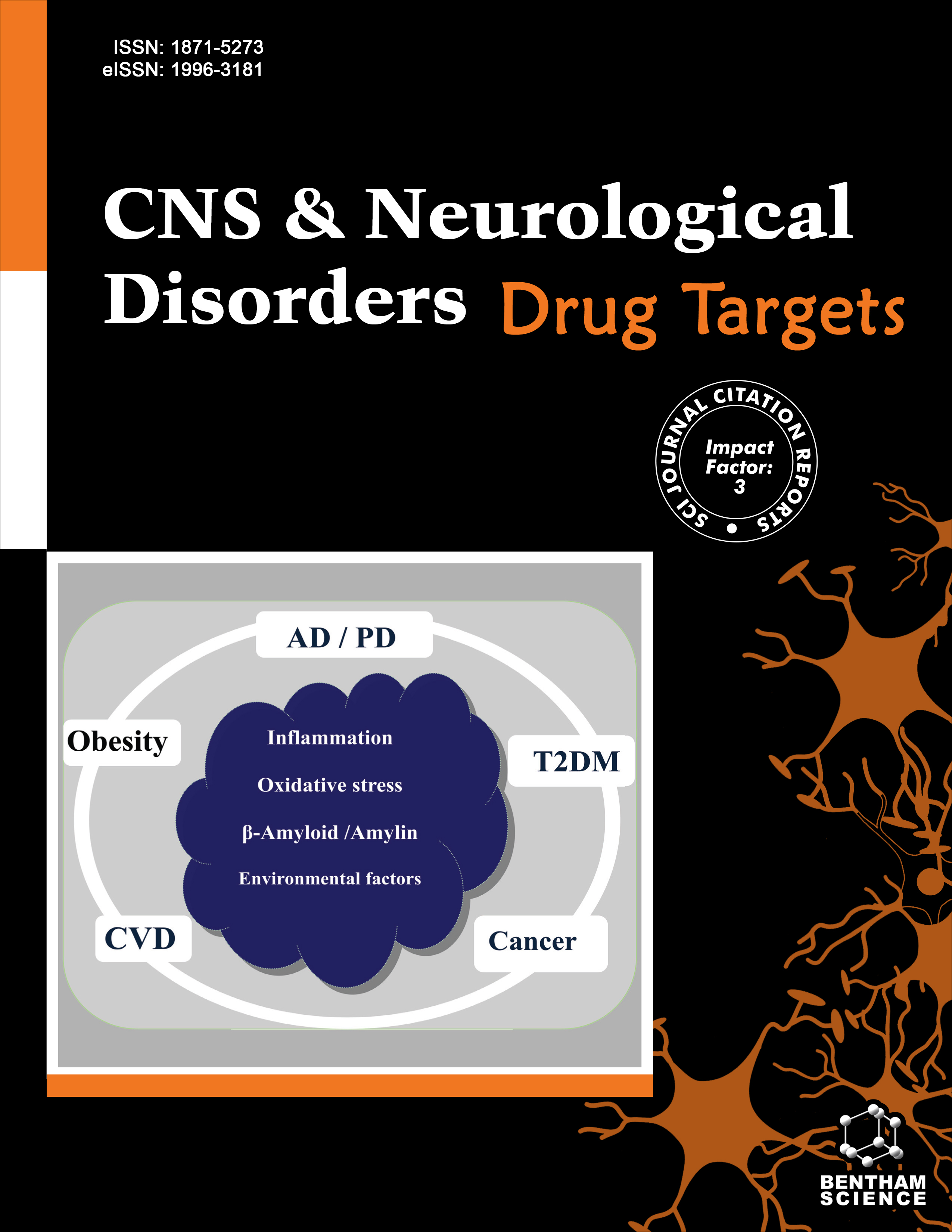- Home
- A-Z Publications
- CNS & Neurological Disorders - Drug Targets (Formerly Current Drug Targets - CNS & Neurological Disorders)
- Previous Issues
- Volume 23, Issue 11, 2024
CNS & Neurological Disorders - Drug Targets (Formerly Current Drug Targets - CNS & Neurological Disorders) - Volume 23, Issue 11, 2024
Volume 23, Issue 11, 2024
-
-
Flow Diversion for the Management of Posterior Circulation’s Intracranial Aneurysms
More LessThe endovascular treatment of posterior circulation aneurysms, although challenging, has been well-established due to various factors that limit the surgical approach in most cases. Flow diversion has also been utilized in the treatment of such aneurysms, although its effectiveness and safety still require evaluation. Numerous studies have examined the outcomes and complication rates in patients treated with FD, resulting in v Read More
-
-
-
Vasospasm in Pediatric Subarachnoid Hemorrhage
More LessAuthors: Ioannis Mavridis, Efstratios-Stylianos Pyrgelis, Eleni Agapiou and Jeries AssiCerebral vasospasm (CV) is a common severe complication of subarachnoid hemorrhage (SAH), a severe type of intracranial bleeding that is uncommon in children. The purpose of this article is to review the current literature regarding this potentially devastating complication. CV may be asymptomatic and is less common in children compared to adults. Several molecular phenomena, including inflammatory ones, contrib Read More
-
-
-
Pharmacotherapy in SAH: Clinical Trial Lessons
More LessAuthors: Sotirios Apostolakis and Pantelis StavrinouSubarachnoid Haemorrhage (SAH) is a medical emergency with potentially devastating outcomes. It is without doubt that over the past decades, there has been a radical change in the approach towards patients with SAH, both in terms of the surgical as well as of the pharmacological treatments offered. The present review aims to outline the principal data regarding the best practice in the pharmacotherapy of SAH, as Read More
-
-
-
The Landscape of Randomized Clinical Trial Meta-analyses on Statins for Aneurysmal Subarachnoid Hemorrhage: A Scoping Review
More LessIntroduction: Aneurysmal subarachnoid hemorrhage (aSAH) is a type of non-traumatic SAH that can have detrimental effects on the central nervous system, resulting in severe disability or death. Methods: Early nimodipine is currently the only strongly recommended pharmacological treatment that has shown efficacy in improving neurological/functional outcomes in aSAH patients. Whether statin treatment is of benefi Read More
-
-
-
GFAP and UCHL1 in Non-traumatic SAH: The Story thus Far. A Systematic Review of the Literature
More LessObjective: Non-traumatic subarachnoid hemorrhage (SAH) is associated with a high percentage of misdiagnosis and poor prognosis. Biomarkers could be useful in the identification, treatment/management guidance, and outcome improvement of SAH patients. The current systematic review aims to investigate the potential role of biomarkers GFAP (Glial Fibrillary Acidic Protein) and UCH-L1 (Ubiquitin C-Terminal Hydrolase L1) i Read More
-
-
-
Emerging Treatments for Subarachnoid Hemorrhage
More LessThe current landscape of therapeutic strategies for subarachnoid hemorrhage (SAH), a significant adverse neurological event commonly resulting from the rupture of intracranial aneurysms, is rapidly evolving. Through an in-depth exploration of the natural history of SAH, historical treatment approaches, and emerging management modalities, the present work aims to provide a broad overview of the shifting paradigms in SA Read More
-
-
-
Unraveling the Emerging Niche Role of Extracellular Vesicles (EVs) in Traumatic Brain Injury (TBI)
More LessAuthors: Sumel Ashique, Radheshyam Pal, Himanshu Sharma, Neeraj Mishra and Ashish GargExtracellular vesicles or exosomes, often known as EVs, have acquired significant attention in the investigations of traumatic brain injury (TBI) and have a distinct advantage in actively researching the fundamental mechanisms underlying various clinical symptoms and diagnosing the wide range of traumatic brain injury cases. The mesenchymal stem cells (MSCs) can produce and release exosomes, which offer therapeutic Read More
-
-
-
Gastrointestinal Issues in Depression, Anxiety, and Neurodegenerative Diseases: A Systematic Review on Pathways and Clinical Targets Implications
More LessIntroduction: Multiple illnesses commonly involve both the Central Nervous System (CNS) and the Gastrointestinal Tract (GI) simultaneously. Consistent evidence suggests that neurological disorders impair GI tract function and worsen the symptomatology and pathophysiology of digestive disorders. On the other hand, it has been proposed that early functional changes in the GI tract contribute to the genesis of several CNS Read More
-
-
-
T Lymphocyte Interferon-gamma Response to Anaplasmataceae-related Major Surface Proteins and Ankyrin A in Fibromyalgia
More LessAuthors: Basant K. Puri, Rosemarie Preyer, Gary S. Lee and Armin SchwarzbachBackground: The aetiology of fibromyalgia is unknown; its symptoms may be related to a T-lymphocyte-mediated response to infectious organisms. Objectives: First, to test the hypothesis that fibromyalgia is associated with increased interferon (IFN)-γ-secreting T-lymphocytes after stimulation with Anaplasmataceae-related major surface proteins (MSPs) and the macromolecular translocation type IV secretion system effector a Read More
-
Volumes & issues
-
Volume 24 (2025)
-
Volume 23 (2024)
-
Volume 22 (2023)
-
Volume 21 (2022)
-
Volume 20 (2021)
-
Volume 19 (2020)
-
Volume 18 (2019)
-
Volume 17 (2018)
-
Volume 16 (2017)
-
Volume 15 (2016)
-
Volume 14 (2015)
-
Volume 13 (2014)
-
Volume 12 (2013)
-
Volume 11 (2012)
-
Volume 10 (2011)
-
Volume 9 (2010)
-
Volume 8 (2009)
-
Volume 7 (2008)
-
Volume 6 (2007)
-
Volume 5 (2006)
Most Read This Month
Article
content/journals/cnsnddt
Journal
10
5
false
en

Most Cited Most Cited RSS feed
-
-
A Retrospective, Multi-Center Cohort Study Evaluating the Severity- Related Effects of Cerebrolysin Treatment on Clinical Outcomes in Traumatic Brain Injury
Authors: Dafin F. Muresanu, Alexandru V. Ciurea, Radu M. Gorgan, Eva Gheorghita, Stefan I. Florian, Horatiu Stan, Alin Blaga, Nicolai Ianovici, Stefan M. Iencean, Dana Turliuc, Horia B. Davidescu, Cornel Mihalache, Felix M. Brehar, Anca . S. Mihaescu, Dinu C. Mardare, Aurelian Anghelescu, Carmen Chiparus, Magdalena Lapadat, Viorel Pruna, Dumitru Mohan, Constantin Costea, Daniel Costea, Claudiu Palade, Narcisa Bucur, Jesus Figueroa and Anton Alvarez
-
-
-
- More Less

